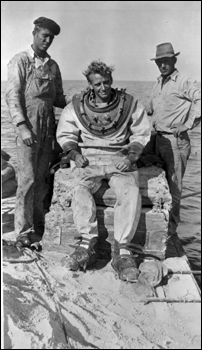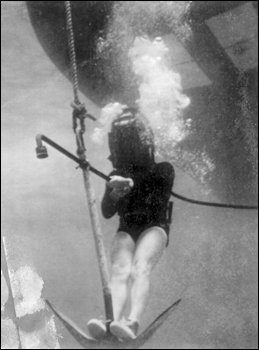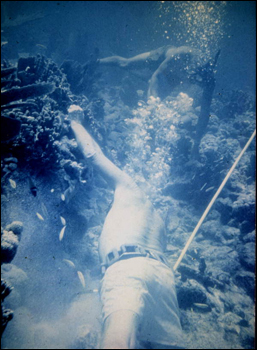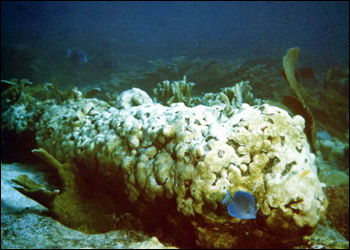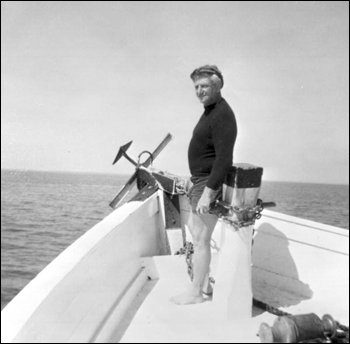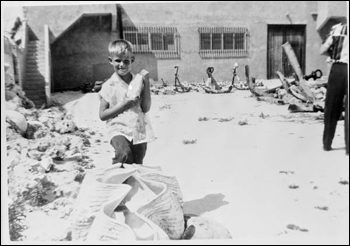Photo Exhibits
Photo exhibits spotlight various topics in Florida history, and are accompanied by brief text intended to place selected materials in historical context.
Florida Archaeology
Studying and Exploring 12,000 Years of Floridians
Art McKee, "The Treasure Hunter"
Arthur McKee Jr., known as Art "Silver Bar" McKee, was a noted Florida treasure diver for many years and is often referred to as "the father of modern treasure diving." Sometimes called "The Treasure Hunter's Treasure Hunter," McKee pioneered salvage work on historic shipwrecks in the days before scuba diving became popular.
Art McKee was born in Bridgeton, New Jersey, on November 2, 1910, and spent his teenage summers as a lifeguard teaching others to swim and free dive. After high school, he worked as a tender for an old helmet diver who was repairing a bridge on the Delaware River. Seeking warmer and clearer waters, he moved to Florida in 1934 and got a job as chief diver for the underwater pipeline that ran from Homestead to Key West. He then worked as recreational director for the City of Homestead for ten years. On his days off, he explored the offshore reefs with his hard-hat diving rig salvaging old iron and brass from shipwrecks.
Art being suited for Moser Channel project. (1942)
Image Number: AM0072
Treasure hunter Art McKee riding the Jolly Roger anchor down to the site of "El Capitana" wreck : Florida Keys, Florida (c. 1960)
Image Number: AM0046
In 1937, a commercial fisherman showed McKee a pile of ballast stones and cannons off Plantation Key, and McKee began to find Spanish silver coins, including one gold escudo coin dated 1721. Curious about his find, he wrote to the Archive of the Indies in Spain and received a packet of documents relating the fate of the 1733 Spanish treasure fleet that was wrecked in the Florida Keys during a hurricane. From translations of the documents, McKee learned that the wreck off Plantation Key was the Capitana, El Rubi Segundo, flagship of the fleet. During the next ten years, he and his partners searched up and down the Keys, exploring more than 75 shipwrecks. Meanwhile, during World War II, McKee worked as a diver for the Navy (1941-1942) on the construction of the freshwater pipeline.
Art working edge of ballast pile of what is believed to be the Genovesa shipwreck (1979)
Image Number: AM0207
The Genovesa shipwreck was his last treasure hunting project before he died.
Coral encrusted cannon on the Genovesa wreck site at Pedro Banks in Jamaica (1979)
Image Number: AM0202
Accompanying note: "Spanish ship loaded w/gold & silver that went down in Jamaica."
In 1948, McKee found the remains of the 1733 lost Spanish fleet. Among the cannons, ballast, and other treasures were silver coins dated 1732. He brought up so many bars of silver that he gained the nickname of "Silver Bar McKee." In 1949, having a warehouse full of artifacts and treasure from several different wrecks, McKee opened to the public the first museum in the world devoted to sunken treasure, on Plantation Key at Treasure Harbor. He took visitors to the Capitana in his glass-bottom boat, and he took many of them on underwater tours in his diving helmet. Three years later he opened his "Treasure Fortress," later known as Treasure Village.
Treasure hunter Art McKee standing at the bow of a boat (1967)
Image Number: AM0076
Art McKee's son, Mick, posing with items at his father's museum : Plantation Key, Florida (1956)
Image Number: AM0126

 Listen: The Blues Program
Listen: The Blues Program